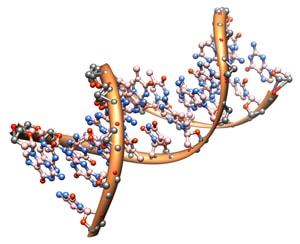By Michael D. Shaw March 5, 2018 @ Health News Digest
 These days, every middle school student can tell you that deoxyribonucleic acid (DNA) is the molecular basis of all life (except for those pesky RNA viruses). But, the identification of DNA as the carrier of genetic material (Oswald T. Avery, Colin M. MacLeod, Maclyn McCarty) would not come until 1944. DNA was first isolated in 1869 by Swiss physician and biologist Friedrich Miescher. And, this was just a few years after Augustinian monk and scientist Gregor Mendel published his breakthrough paper “Experiments on Plant Hybrids,” that established him as the father of modern genetics.
These days, every middle school student can tell you that deoxyribonucleic acid (DNA) is the molecular basis of all life (except for those pesky RNA viruses). But, the identification of DNA as the carrier of genetic material (Oswald T. Avery, Colin M. MacLeod, Maclyn McCarty) would not come until 1944. DNA was first isolated in 1869 by Swiss physician and biologist Friedrich Miescher. And, this was just a few years after Augustinian monk and scientist Gregor Mendel published his breakthrough paper “Experiments on Plant Hybrids,” that established him as the father of modern genetics.However, Mendel spoke of “factors” in inheritance.
It would not be until 1909 that Danish botanist Wilhelm Johannsen coined the word “gene” (“gen” in Danish and German) to describe these fundamental physical and functional units of heredity. And, in 1953 came the biggest breakthrough of all, in which James Watson and Francis Crick published their famous letter entitled “Molecular Structure of Nucleic Acids: A Structure for Deoxyribose Nucleic Acid.”
Growing up in the 1960s, we would hear constantly how knowledge of DNA would one day cure cancer and other devastating diseases, and that some day we might even be able to map the entire human genome. As it happens, the entire human genome was mapped by April 14, 2003. The actual number of protein-coding genes seems to be around 20,500.
For the record, certain forms of cancer are now cured much of the time, and others have become readily survivable—although this does not have much to do with DNA research.
Ironically, the biggest application of DNA at present—which was not even suggested by the pundits in the 1960s—is, of course, forensics. Hindsight might be 20/20, but when one considers that every person’s DNA is absolutely unique to him or her, and that many crime scenes will contain DNA-rich bodily fluids, why didn’t the pundits think of this? My guess is that in the rarefied world of Science, crime-solving was far too mundane—or practical—to even be on the radar screen.
The first murder conviction based on DNA occurred in the UK, and sent Colin Pitchfork to prison for life (minimum term 30 years), for two homicides, in January, 1988. The first American case involved multiple felon Timothy Spencer, who was convicted of rape and homicide in two separate cases, September, 1988 and January, 1989. Spencer was executed in 1994. Amazingly, in both the Pitchfork and Spencer offenses, wrongly convicted individuals were set free—exonerated by DNA evidence.
The true scientist-hero of forensic DNA is Sir Alec Jeffreys, who developed the original methodology. A close second would be Nobel Laureate Kary Mullis for polymerase chain reaction, a technique that allows the use of much smaller DNA samples.
A more fun application of DNA, growing in popularity, is tracing your ancestry. The algorithms are improving all the time, and millions of people have submitted samples, and are fascinated and often surprised by the results. We have been made aware of a special offer from FreeDNAtest.com. The company will be giving away up to one million DNA tests.
Let’s hear from Mike Freedom, Founder of FreeDNAtest.com:
“Each person is a chapter in the story of humanity. DNA is the common language by which we tell this tale, though the sentences and paragraphs, so to speak, differ with each individual. To know that story—to know your own story—is to know how your DNA determines the context of your story. It determines many things, but it is not determinative in its own right; because your DNA is not your destiny, as that is something far beyond the dictates of biology. Still, everyone has a right to know his or her story. FreeDNAtest.com brings your story to life.”
No comments:
Post a Comment